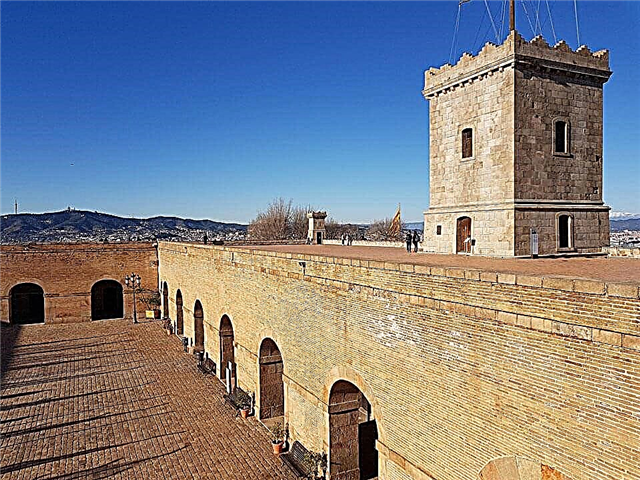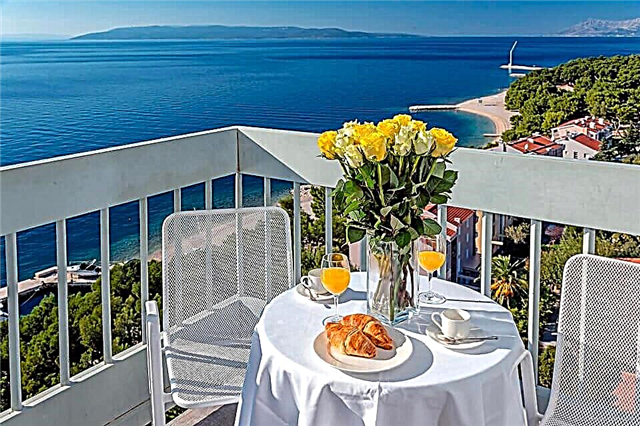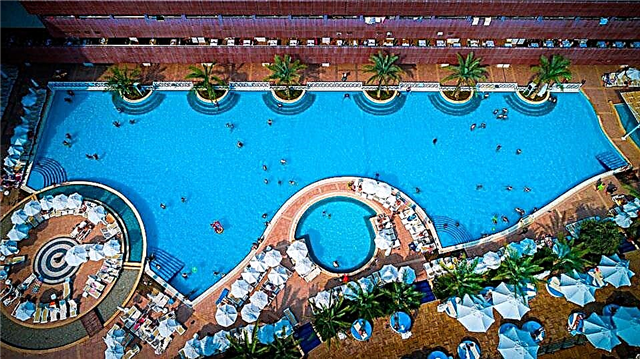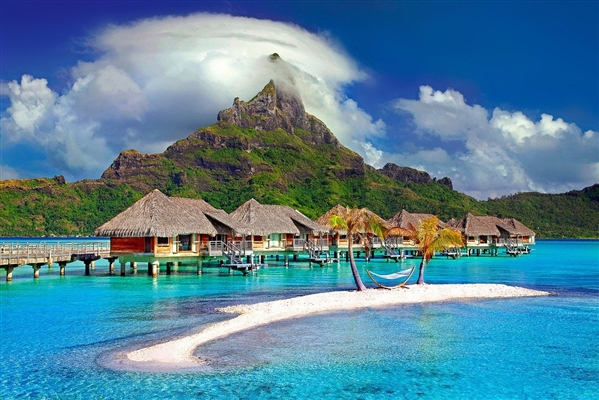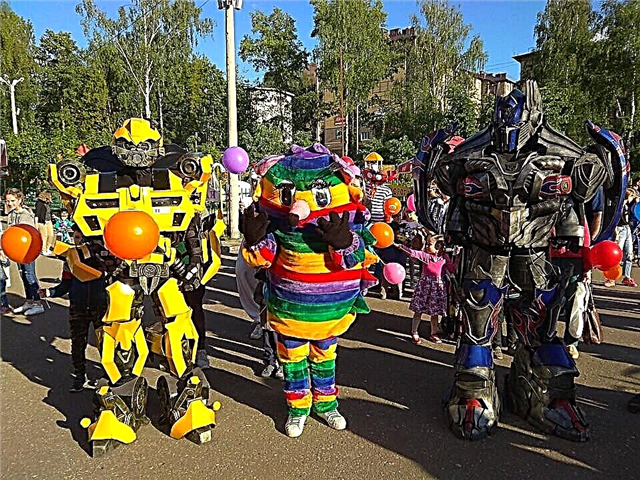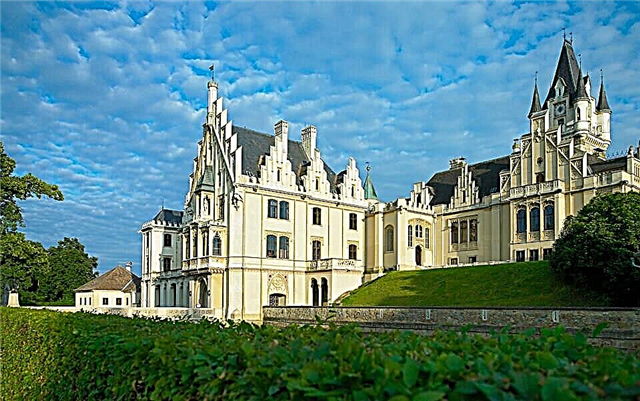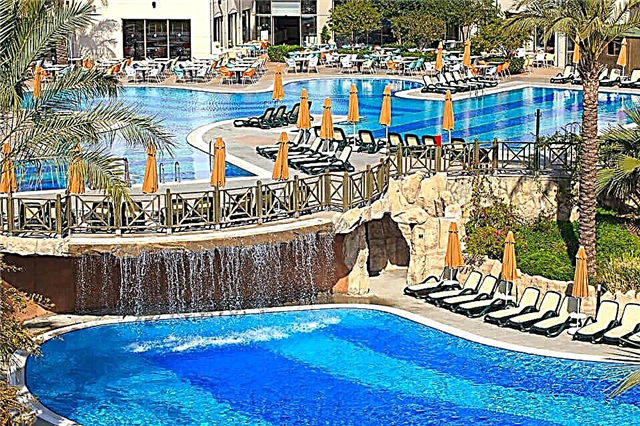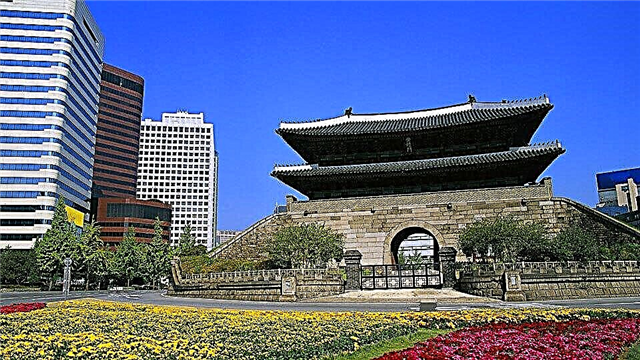The harmony of opposites reigns in the capital of Korea. Ancient monuments are surrounded by ultra-modern skyscrapers, the largest Asian high-tech industries are adjacent to magnificent parks, universities, scientific centers are located next to the sanctuaries where the spirits of ancestors are worshiped. Seoul's landmarks and common city buildings form a fantastic architectural mosaic. The secret to the miracle of harmony is simple: a neat layout. It became a key rule of Korean urban planning more than 600 years ago. Time has confirmed the relevance of this approach. The metropolis amazes with its scale, grooming, the ability of its inhabitants to protect nature, to preserve the spirit of antiquity. However, at the head of these qualities remains precisely the accuracy that Koreans consider to be among the main virtues.
Cheonggyecheon Stream

The 11 km long recreational zone with this name is located in the very heart of the city. The first attempt to improve the territory was made 600 years ago, when bridges were built across the stream and work began to clean up its bed. In the middle of the 20th century, after the Korean War, slums appeared near the source. In the 70s, the stream was "hidden" under the highway, and 30 years later the city authorities decided to demolish it and restore the recreation area.
The park was opened in 2005. On its territory, fountains, bridges were built, crossings over the water stream were equipped over stones, and benches were installed. Local craftsmen have transformed the gray concrete walls along the stream, decorating them with paintings and ceramics. At night, the park is illuminated by illumination lights, turning it into a fabulous space. The entrance to the recreational area is free.
Gyeongbokgung

The royal palace was built in the XIV century. The time of its construction and the transfer of the capital of Korea to Seoul coincide. At the end of the 19th century, the palace complex consisted of 330 buildings. 10 of them were demolished during the next Japanese occupation, but most of the structures survived. Today the palace complex covers an area of about 410 thousand square meters. One of its main buildings: Geunjongjon - a throne room decorated with paintings and statues of animals.
The second most important building, the Gyeonghweru Pavilion, houses the National Folk Museum. This building on 48 granite piles is located in the center of a man-made lake and looks especially impressive during lotus blooming. The Palace Gate, where the changing of the guard in antique clothes takes place, is a favorite selfie spot and landmark for tourists looking for the National Palace Museum (located nearby).
Bridge "Fountain of the Rainbow"

The length of the world's longest bridge-hydraulic structure: more than a kilometer. The "Rainbow Fountain" was opened in 2009, and since then it has not lost its popularity among guests and residents of the city. The fountain is operated by 38 pumps. At the same time, it serves as a wastewater treatment plant. In a minute, 190 tons of water from the Hangang River "pass" through its filters and return back into it.
The throwing range of water jets varies from 20 to 40 meters. The hydraulic structure looks impressive at any time of the day. The fountain operates every day with breaks from 20 to 60 minutes (depending on the day of the week). At night, the backlight turns it into a rainbow shining in the dark. There is a park next to the bridge with recreation areas overlooking the fountain.
Mapo bridge

The infamous building was built in the 70s of the last century. The city authorities renamed it “The Bridge of Life”, hoping to deceive fate, and the townspeople still call it: “The Bridge of Death”, “The Bridge of Despair”, “The Bridge of Suicides”. Previously, 13% of cases of settling accounts with life took place here, since 2013 the numbers have decreased, but the problem remains. The proximity of the capital's financial center adds fuel to the fire: it is businessmen in Korea who most often become suicides.
Up to $ 2 million annually go to the maintenance of the rescuers assigned to the bridge from the city treasury. To somehow change the situation, the local authorities decided to turn the pedestrian zone of the bridge into a place of psychological relief. For this, mirrors, plates with funny inscriptions, photographs of Korean cuisine, sculptures were placed along the parapet. Surprisingly, they really stop the desperate townspeople from taking a fateful step.
Bukhansan National Park

The area of the smallest and most visited national park in the world: 80 square kilometers. It occupies part of the city and the neighboring province. Bukhansan receives over 5 million tourists annually. The park spans 3 mountain peaks, each with its own name. Scientists estimate that there are about 2,500 species of plants, mushrooms and animals here.

At the same time, the natural zone serves as an open-air museum. In Bukhansan, fragments of the fortress wall, erected 2,000 years ago, and about 100 Buddhist temples have been preserved. For the convenience of guests, the park is equipped with historical, sports, educational walking trails designed for visitors of different ages and physical abilities.
Trick Eye Museum of Optical Illusions

The name of the museum is borrowed from the French language, it means: "optical illusion". Its exhibits can be touched, photographed, excursions are allowed to be recorded on video, which undoubtedly adds popularity to the art object. The museum is annually visited by 300 thousand people from all over the world. The art object consists of thematic galleries dedicated to history, world art, romance, luxury, traditions, mirrors, and everyday life.
The latter can turn out to be an extremely entertaining spectacle if, with the help of special effects, familiar information is presented in a new light. Famous parts of the art object are the museums of love and ice. Access to the Love Museum is prohibited for minors. The Ice Museum, home to magnificent ice sculptures, is open to visitors of all ages. The Trick Eye Museum has several branches located outside of Seoul.
Namsan Cable Car

Namsan is a classic example of how a funicular can be turned into one of the city's top attractions. It carries about 50 thousand passengers every month. The cable car route spans the peaks of Namsan Mountain and Seoul TV Tower. The funicular began operating in the 60s of the last century. Since that time, the structure has been reconstructed several times, which made it possible to make the "air route" as comfortable and safe as possible.
Each cable car can accommodate up to 48 passengers. Transparent walls allow you to freely admire the beauty of the city, nature in the dark and during the day. Chances are high that the cable car will disappear from the map of Seoul in the coming years. The city authorities are considering projects to replace the funicular with special lifts, where the role of cabins will be performed by gondolas with a smaller capacity.
Seoul TV Tower

The building has several names, which is quite symbolic, because it performs various functions. YTN Seoul Tower, N Tower and Namsan Tower are all one structure, which is 236 meters high. The landmark is located on Mount Namsan; in the 70s, the tower was the first such object in Korea. It continues to provide broadcasting of local television and radio studios, and is the most popular observation deck in the city. The tower was renamed several times, but it remains the symbol of the city even today.
The building is divided into 3 parts. In the lower and middle, there are souvenir shops, cafes, bars, ticket offices, a museum and a special room for parents with children.The upper part consists of 4 floors where shops, observation decks and restaurants work. Among the most famous objects in this sector: a digital observatory, a revolving restaurant, a pond where visitors throw (making wishes) coins.
Namsan Village Hanok Traditional Korean Residence Museum

The Namsangol Hanok Village Open Air Museum is located in the city center. It is surrounded on all sides by skyscrapers. The museum consists of 5 houses, pavilions, gazebos, and performance areas. The complex has a traditional Korean garden, pond, stream. The museum covers an area of about a hectare. For Seoul residents, this plot was enough to create an authentic rural atmosphere.
The only caveat: officials, wealthy aristocrats, members of the imperial family could afford the construction of the houses presented here. However, the household items placed in the premises belonged to representatives of different social strata. The museum began to receive visitors in 1998; it took 10 years to create it. The entrance to the village is free and is open from April to October. At this time, master classes in folk crafts, special events (including weddings) are held here.
Skyscraper Lotte World Tower

The construction of a building on the territory of the entertainment complex was accompanied by scandals. The construction process of the skyscraper took 9 years, the work of the architects - 7 years. It took 15 years to get permission from the authorities to build the 123-story tower. Those who love to tickle their nerves (in the forefront are Russians) illegally entered the protected area of the facility and took photographs ... Even the opening ceremony of the tower was postponed - a two-story elevator was out of order.
The skyscraper is recognized as a leader among similar structures in Korea and the world for a variety of indicators. The building houses offices, shops, restaurants. There is a 10-storey shopping center and an elite hotel here. Total height of the building: 555 meters. On its 85th floor there is a swimming pool, at an altitude of 500 meters there is an observation deck, whose floor is made of heavy-duty glass.
War Memorial of the Republic of Korea

The museum complex was built in the 90s of the last century, it covers an area of 20 thousand square meters. A visit to the memorial is a tribute to the soldiers who fought for the independence of Korea. There are monuments with carved names of the dead servicemen. Police officers are buried on the territory of the memorial. The most famous monument of the complex - the Statue of the Brothers - is located in its central square.

It symbolizes the unity of the people living in North and South Korea, which does not negate the possibility of a war between states to this day. Memorial Main Building: The headquarters of the Korean Army, displaying unique collections of ancient and modern weapons. The exposition of military equipment (including aircraft, tanks) is located nearby in open areas.
Gwanghwamun Square

An architectural masterpiece created in the 21st century. More than 40 thousand people visit the square every day (this figure doubles on holidays). The names of the adjacent gates of the ancient Gyeongbokgung palace complex and the modern square are the same. This is very symbolic for Koreans, who are proud of the history of the state and honor the memory of the Joseon imperial dynasty, who owned the palace.
Each element of the square, whose length is 557 meters, carries a huge semantic load. The number of plants in the flower garden corresponds to the number of days since Seoul became the capital of Korea. The fountain numbers are reminiscent of the victories over the Japanese navy. The stones submerged in the water are engraved with the dates of the most important events in the history of the city. Stones without inscriptions have a special place - they are waiting for their turn.
Olympic park

The largest park in the city is aimed at outdoor enthusiasts. The sports recreational area covers an area of over a million square meters. The park was opened in the 80s of the last century on the eve of the Olympic Games. Indoor sports palaces and stadiums operate on its territory, a 17-storey Olympic Center, a swimming pool, a velodrome and other facilities are located. The famous Olympic Museum is also located here.

The symbol of the park is the Gate of Peace on Earth. A masterpiece of modern architecture, 24 meters high, made of concrete, decorated with mosaics with images of dragons. The park is famous for its sculpture garden and art museum. It attracts those who study Korean history. The walls of the ancient Moncheontoseong fortress preserved in the park - the pearl of the complex - remind of the times when the city existed under the threat of invading invaders from the north.
Changdeokgung

The construction of the palace complex dates back to the beginning of the 15th century. The buildings were destroyed by the Japanese invaders, the buildings were on fire, but the palace, after repeated restoration, was preserved unchanged in architecture. Today, there are 13 main structures on the territory of the complex, including the oldest bridge, the royal bedchamber, the throne room, and the queen's residence. The site is included in the UNESCO World Heritage List.
Luxurious gardens, 300-year-old trees, galleries, pavilions, artificial reservoirs create an atmosphere of tranquility here, emphasizing the splendor of buildings for official ceremonies. Residents believe: Chandokgun was erected on a magical place, because auspicious energy descends from the top of the mountain. The palace has belonged to the ruling Korean dynasty Jeongseon for centuries. By the will of fate, it was here that it was interrupted when the last emperor of Korea, Sunjon, who was deprived of the opportunity to rule the country, died.
Seodaemun prison

The building was erected at the beginning of the 20th century, when the power in the state actually belonged to the Japanese. The structure was built in a year, it changed its name several times and until the 80s performed exclusively the functions of a prison. The building became a famous landmark because political criminals were serving their sentences there. Among them: Lee Myung-bak, who was elected president of South Korea, then stepped down from power and then ... ended up in another prison for bribery and corruption.
Seodaemun is currently a museum. The structure has been preserved from the moment of its construction without significant changes. Historians managed to completely recreate the atmosphere that reigned in the watchtower, torture room, and prison cells. In the halls of the museum, documents from the times of the Japanese occupation, personal belongings of fighters for the independence of Korea, photographs, paintings dedicated to the history of the state are displayed.
Museum of Art "Lium"

It was created and operates thanks to the support of the world famous Korean company Samsung. In travel guides, it is often referred to as a gallery of Korean contemporary art, which is not entirely true. The art object includes two separate exhibition pavilions and a children's educational center. There are many foreign citizens among the authors of the works presented here, including the British and French.
Innovative technologies have allowed the organizers of the expositions to translate into reality the idea of a harmonious art space that unites aesthetic opposites. The first gallery presents masterpieces of painting, arts and crafts, created before and during the reign of the Joseon dynasty. In the second - the brilliant creations of contemporary sculptors and artists. It is noteworthy: the buildings of the pavilions fully correspond to the exhibits. One was built following the example of medieval Asian fortresses, the other - in the spirit of futurism.
Myeongdong Cathedral

The cathedral was built according to the canons of the neo-Gothic style. Height of the building including the spire: 70 meters. There is a clock on the top of the temple tower. At the beginning of the last century, the cathedral was the tallest building in the city. It is named after the Immaculate Conception of the Virgin Mary.The main relic of the temple: the burial place of local martyrs - clergymen who died during the reign of the Joseon dynasty.
This unique architectural monument is recognized as a national treasure, it was built at the expense of French Christian missionaries. The ambiguous attitude of the generally tolerant people of Seoul towards the temple and its arrival is explained by the following. The traditional religion of Korea is Buddhism, and it influences government policy. Christians in the state are a religious minority, but they constantly participate in opposition movements, guided by the ideals of European democracy, which does not in the best way affect the reputation of the church.
Dongdaemun Gate

The magic of the oldest city building, a business card, is difficult for Europeans to understand. "Dongdaemun" is an ambiguous expression. If translated literally, it is simply "the great gate on the east side." The gate has another name: Hyninjimun - "the place where kindness (virtue) rises". It is also associated with the East, which among Koreans symbolizes material and spiritual benefits.
The gate, according to the beliefs of many peoples, is an important link between the worlds of the living and the dead. The destruction of such structures among Koreans is comparable to a national tragedy. Therefore, taking care of Khyninjimun is at the same time preserving a unique monument, showing respect for the memory of ancestors and piety. Dongdaemun were built at the end of the XIV century.
Since then, the facility has been reconstructed several times. The gate acquired its current appearance in the 19th century. Once they were part of the fortress wall, they performed defensive functions. For centuries, representatives of the ruling Korean dynasty Joseon allocated funds for the restoration of the gate.
Dongdaemun Market

The trading floor is located next to the gate of the same name. This is a quite common practice in the East, when neighboring streets, squares and even buildings are named after one famous object. Tourists often have to clarify "which of the tondemuns" they want to see, which, in general, is not necessary, because the same named ancient monuments are usually located within walking distance from each other.
The market was opened at the beginning of the last century. During the Korean War, Dongdaemun remained in ruins, but it was rebuilt. Today over 150 thousand Korean citizens work here, 7% of the market personnel are professional designers. Today, Dongdaemun, the largest wholesale and retail trading platform, serves as a giant branded clothing factory. The market where you can bargain and buy quality items is always popular with tourists and residents of the city.
Deoksugung Palace

The palace-residence of the Joseon dynasty that ruled in Korea dates back to the 15th century. Deoksugun is part of the complex of five main royal palaces, but is inferior in size to similar structures. The main feature of the residence: European architectural solutions were used in the construction of a number of buildings. At one time, conservative Seoulians compared this to a challenge to the traditions of their ancestors.
Deoksugung consists of 12 facilities and covers an area of over 60 thousand square meters. Initially, there were 180 buildings. Fires and wars caused irreparable damage to the residence, but even today the Deoksugun hidden behind the fortress wall looks peaceful and solemn. On its territory, a garden and secret passages have been preserved, which allowed members of the royal family to save their lives.
The palace was first opened to the public in the 30s of the last century. Here you can see the rooms where the representatives of the Joseon dynasty lived, exhibitions of palace treasures and works of modern art.
National Museum of Korea

One of the most popular art objects in Asia covers an area of about 137 thousand square meters and is among the top most visited museums in the world. It is a unique cultural center where, as if in a fantastic reality, various trends of art are intertwined. The museum displays unique artifacts, historical relics, works of Korean masters and masterpieces created in neighboring states.

His first exhibitions were opened in 1945. In order to protect 220 thousand unique relics from natural disasters and pass them on to descendants, a new special building was erected for the National Museum in the 21st century. Outwardly, it resembles a medieval Asian fortress. Even if earthquakes destroy neighboring skyscrapers, the museum, as seismologists assure, will withstand. The structure of the art object includes galleries, lecture halls, exhibition halls, cafes and restaurants intended for children.
Bongeunsa temple

Guidebooks assure: there is no analogue of this building in the world. Age of the Buddhist shrine: over 1200 years old. The difference between the ancient and modern location of the temple: about a kilometer. Initially, the building served only a cult role. Today the activities of the temple include the functions of a cultural center. From the clergy, you can learn a lot about Korean folk traditions and customs.
The temple complex is located in the most prestigious area. He gives the impression of complete detachment from the hustle and bustle. There are no noisy crowds of tourists here. Mass religious holidays in the temple are quiet, decorous. He, as the Seoul people say, is ideal for meditation. The first daily temple service begins at dawn. Pilgrims from all over the world come to pray to the main relic of Bongeuns: an ancient stone statue of Buddha, whose height is 28 meters.
Bank of Korea Money Museum

Turning the bank's headquarters into a money museum is a very logical decision. However, the expositions located in such a building are devoted not only to numismatics. The main goal of the new cultural object was to promote the economic achievements of the state. The official start date of work is June 13, 2001, but the formation of its funds began earlier. For those who are indifferent to economics and numismatics, it also makes sense to visit this building, whose total area is 8 thousand square meters.
It was built at the beginning of the last century. After hostilities in the 50s, it was restored in record time. The bank office is an atypical architectural monument in Asia. When looking at its exterior, examining luxurious premises, one gets the feeling that a time machine has transported the building from the European Renaissance to modern Korea.
Naksan Park

Literally the name of the park means: "camel mountain". Guests tend to visit it in order to admire the city from the top at any time of the day. The park was opened at the beginning of the XXI century, but the trees located on its territory are much older. Many of them were planted centuries ago and are a memory of the times when Korea was ruled by the Joseon dynasty.
Naksan is intended for lovers of silence and walking, those for whom the beauty of nature is more important than entertainment venues. Its main value: a unique landscape. The main pedestrian park route runs along the ancient fortress wall. The historical monument literally miraculously survived the years of the Japanese occupation of Korea.
Jongmyo shrine

The sanctuary was erected at the end of the XIV century. It acquired its present appearance after 300 years. The stories of the Confucian temple and the ruling Korean Joseon dynasty are closely intertwined. The structure was repeatedly completed, rebuilt after earthquakes, fires, and hostilities. For Seoul people, it has become a symbol of national memory.
The temple is dedicated to the spirits of the kings and queens of the Joseon dynasty, it consists of 19 rooms. The building does not attract attention with the luxury of its interior and exterior decoration. The ascetic structure is intended exclusively for memorial and funeral rites. The sanctuary is named after the rituals performed here by the Confucians.To this day, people are not allowed to enter the southern gate of the temple - they are intended for the spirits of the royal family that interrupted at the beginning of the last century.
Park Overpass Seoullo 7017

The old road junction was expected to be dismantled, but the local authorities found a new use for it. The recreational area was located right on the flyover. The length of the amazing park was about a kilometer. To create it, it took over 24 thousand plants. An important nuance: the city authorities plan to make the park (open for free access) self-sustaining, turning it into a nursery that will supply seeds and seedlings for sale.
The Seoul Skygarden became operational in 2017 and is still under construction. The construction of additional crossings made it possible to connect the park with hotels, shopping and entertainment centers. Additional terraces and art objects appear on the territory of the park these days. Since its inception, Seoullo 7017 has become one of Korea's most popular outdoor exhibition venues.
Starfield Library

The library is open at the COEX shopping center. For several years it has become a world famous cultural object, a favorite place for selfies of guests and residents of the city. There is a version: it was the library from the Hogwarts School of Witchcraft and Wizardry, created by J.K. Rowling's fantasy, that became the prototype of the Seoul miracle.
The Starfield Library holds 50,000 printed publications. The library has departments of electronic books, foreign and Korean periodicals. "Korean paradise for book lovers" covers an area of over 2 thousand square meters. Its shelves are 13 meters high, whimsical installations boggle the imagination. The library has a reading room for 200 seats; meetings with writers, poets, concerts, lectures are regularly held.
COEX Aquarium

The largest Korean oceanarium opened in 2000, it is located on the underground floor of the shopping center of the same name. The COEX Aquarium consists of 6 thematic rooms and covers an area of over a thousand square meters. Today there are 90 observation aquariums in it. There are 40 thousand fish in the aquarium. Among its inhabitants: crocodiles, sea turtles, rays, sharks, polar bears.
Here you can admire exotic plants, hold representatives of the marine fauna in your hands. The aquarium contributes to the preservation of rare species of birds, fish, animals and plants. An important part of his work: social advertising, designed to draw public attention to environmental issues.
Seoul Cathedral Mosque

The building was built in 1976. The mosque serves as the center of Islamic culture in a state where Buddhism is the traditional religion. Koreans are more loyal to Muslims than Christians. Anti-Islamic actions did not escape the state, but the authorities promptly took tough measures against those who incite sectarian strife.
There are 8 mosques in Korea today and about 200 thousand Muslims live. Those who are far from religious prejudices perceive the mosque more as a monument of Islamic architecture. Lectures on Muslim traditions and customs are regularly held here. Near the building there is a huge number of cafes, shops focused on Middle Eastern cuisine.
Unhyeonggung Palace

Residents call this royal residence one of the standards of grace. There are disputes about the exact date of its construction, because the building was often destroyed. The current building is an architectural monument of the 19th century. In the last century, during the Japanese occupation, the layout and exterior of the palace were changed, but restorers managed to save the building.
Unhyeonggun has an exterior style reminiscent of Italian villas. The garden and the palace complex largely correspond to the canons of the neo-Renaissance, but the interior of the premises is traditional, Korean. The building has perfectly preserved halls for ceremonial events, where today museum expositions are located. Nowadays, educational institutions for women and children operate in the palace.


